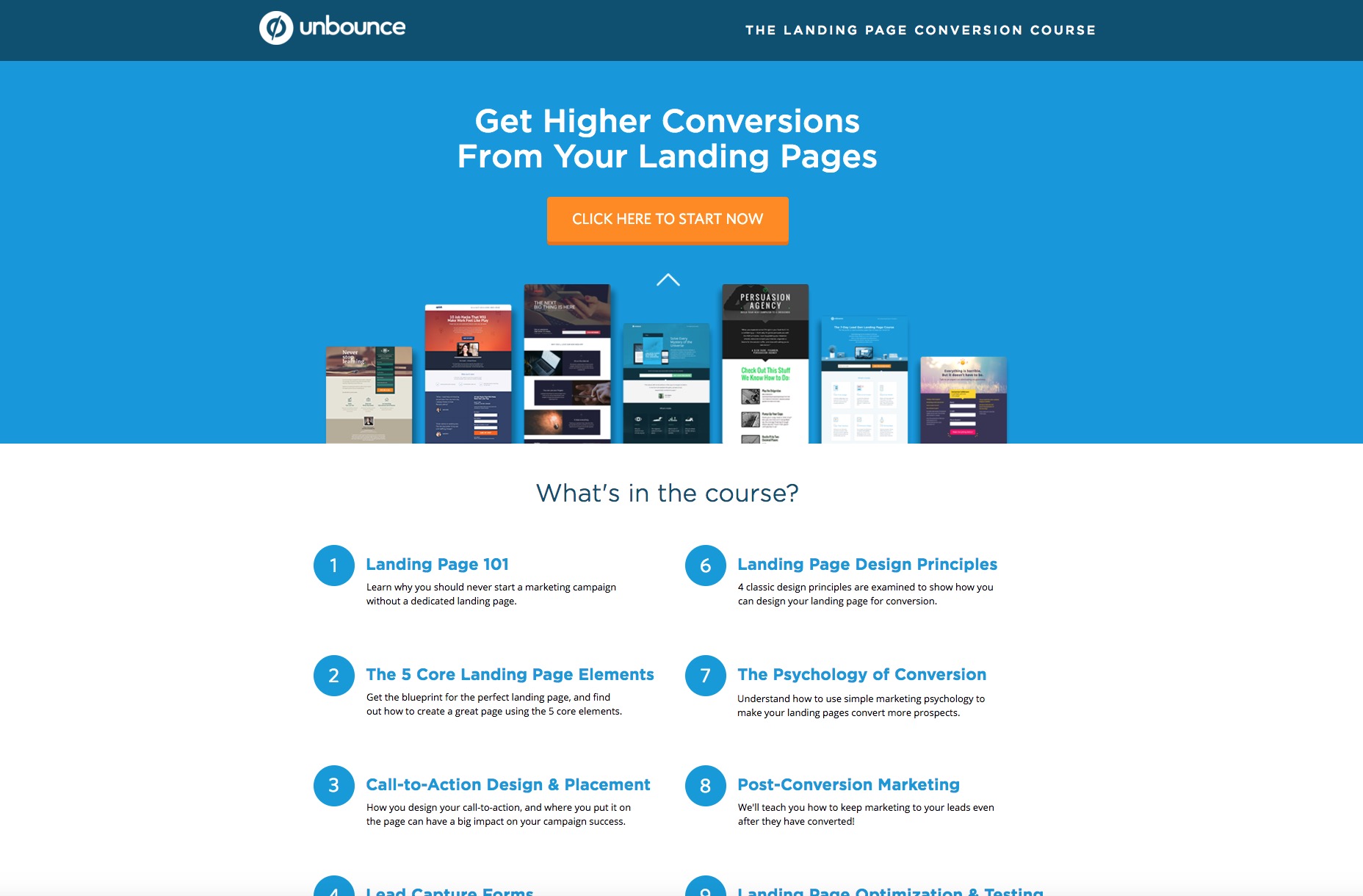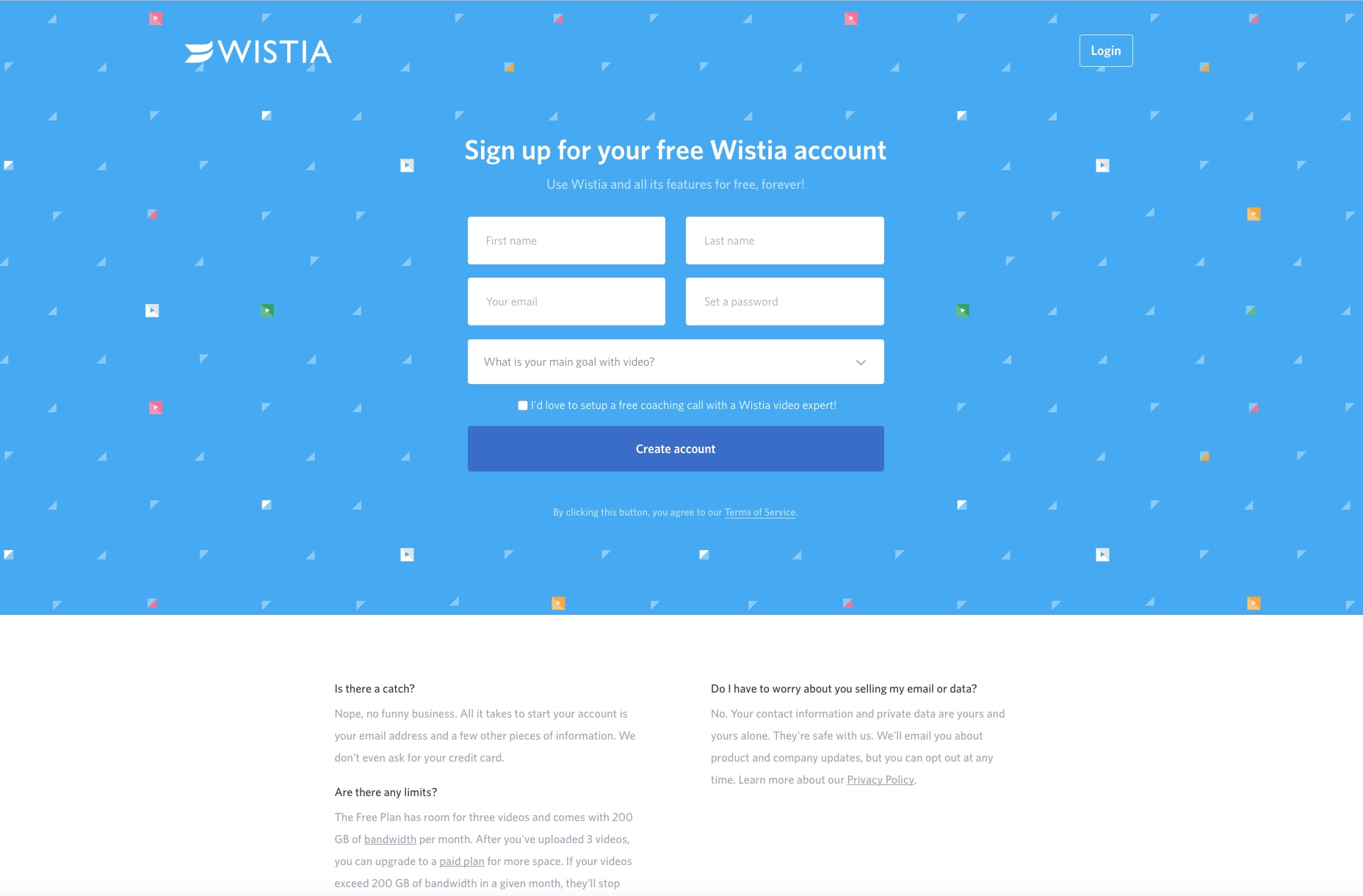Choice paralysis: 3 ways the number of choices impacts conversions

Friction
Friction is defined as anything that upsets or frustrates a user’s easy path to conversions on the landing page. Friction can be anything from an unattractive site that simply drives off visitors because it looks abysmal to a total lack of clarity regarding the ultimate page goal of the landing page. Of course, friction, more often than not, can also be caused by something like having too many choices on the page. When this occurs, as we saw in the jam experiment referenced above, visitors tend to abandon the purchase because they’re suffering from choice overload. Friction is poison to conversions, so anything you can do to keep it to a minimum is necessary. On a landing page, that means removing choices on the page, which can include: • No navigation menu at all• Only one call to action button
• No contact information Unsurprisingly, Unbounce (the specialists in landing-page design) show us how to design a landing page that’s free of friction. On their landing page for the landing-page conversion course, they’ve done away with ANYTHING at all that can cause friction to the goal of the page, which is people clicking the gigantic call to action button to begin reading the chapters in the course. Note how you absolutely can’t click on anything on the page except for the CTA, or the specific chapter headings. Now that boosts conversions.

Interference with the information architecture
Information architecture is defined as a site’s information backbone that essentially informs the entire user interface of a site. In other words, what your users see on the screen, or what they should see on the screen, is a direct result of the IA. Awesome IA means that the whole structure and organization of a site that define the relationship between your content and usability are excellent, too. In the case of a landing page, this means the content has to support the usability (read: visitors being able to efficiently and easily figure out what’s expected of them on the page). If your users can’t quickly determine what they’re supposed to do on the page because there are too many choices, then the content is the problem, and it ends up hampering the relationship between the content and usability. That’s another way of how too many choices can create an adverse impact on a site’s conversions. If users land on a page, yet their flow is interrupted due to excessive choices, chances are slim that they’ll complete the page’s goal, which is to convert. Take a look at this Wistia landing page. It’s information architecture is excellent and is a model of what you should be aiming for in IA. The page goal is clearly to sign up for a Wistia account, which is made clear by the big, noticeable headline. To facilitate that, there’s a giant form right underneath with a big call to action button to finish the purpose of the page’s content. In other words, when visitors look at this page, it’s impossible that they won’t know what to do, and that’s because the IA is on point. There’s to no other choice than to fill out the form!
Cognitive load
Cognitive load is usually defined as the total amount of mental processing power necessary to use a site. It impacts how easily (or hard) users can find content and complete certain tasks. It just stands to reason that, when you have more choices on a landing page, the cognitive load increases. Now, this is where it gets really interesting. Cognitive load can be categorized into two groups: intrinsic and extraneous. Here’s how the two are defined: • Intrinsic - The effort of taking in new information and being mindful of its own goals.• Extraneous - The mental processing that uses up mental resources, yet doesn’t contribute to helping users understand site content. Naturally, when you have too many choices on a landing page, you increase the extraneous cognitive load on users because you’re subjecting them to choices that don’t help them understand the landing page’s content. For example, if the landing page has internal links or a navigation menu, then these choices simply consume a user’s mental processing without helping him understand the page’s content. That would make inclusion of anything other than the bare minimum, the CTA, a problem. With too much cognitive load, users can’t therefore concentrate as efficiently on the ultimate goal of the page, which is to convert, thus driving conversions down. For an example of a landing page that doesn’t subject users to extraneous cognitive load, we look at Trulia. As far as cognitive load goes, this landing page is the perfect epitome of that. The page’s only goal is to get visitors to enter an address, so the site can look up its worth for them. That means there’s no extraneous cognitive load on this page at all! The only actions are: a) Enter your address
b) Click on the call to action button to get your answer The only mental process users undertake is to complete the goal of the page, which they can do in a matter of seconds.

Excessive choices and conversion kills
Psychology is a huge part of web design, including designing a landing page for your clients. You have to understand how users behave on the page when they’re faced with too many choices. Even a few choices can be too many when you consider that any choice that doesn’t support the page goal is excessive and therefore contributes to lower conversions. Case studies like this one—where lessening choices on a landing page boosted conversions by 19%—show that conversions are hurt when you have too many choices on the page. It’s best not to confuse your visitors or altogether tempt them to click away from the call to action on the page. When you design to have only minimal choices, you’re designing for higher conversions and landing-page success!Marc Schenker
Marc’s a copywriter who covers design news for Web Designer Depot. Find out more about him at thegloriouscompanyltd.com.
Read Next
15 Best New Fonts, July 2024
Welcome to our monthly roundup of the best fonts we’ve found online in the last four weeks. This month, there are fewer…
By Ben Moss
20 Best New Websites, July 2024
Welcome to July’s round up of websites to inspire you. This month’s collection ranges from the most stripped-back…
Top 7 WordPress Plugins for 2024: Enhance Your Site's Performance
WordPress is a hands-down favorite of website designers and developers. Renowned for its flexibility and ease of use,…
By WDD Staff
Exciting New Tools for Designers, July 2024
Welcome to this July’s collection of tools, gathered from around the web over the past month. We hope you’ll find…
3 Essential Design Trends, July 2024
Add some summer sizzle to your design projects with trendy website elements. Learn what's trending and how to use these…
15 Best New Fonts, June 2024
Welcome to our roundup of the best new fonts we’ve found online in the last month. This month, there are notably fewer…
By Ben Moss
20 Best New Websites, June 2024
Arranging content in an easily accessible way is the backbone of any user-friendly website. A good website will present…
Exciting New Tools for Designers, June 2024
In this month’s roundup of the best tools for web designers and developers, we’ll explore a range of new and noteworthy…
3 Essential Design Trends, June 2024
Summer is off to a fun start with some highly dramatic website design trends showing up in projects. Let's dive in!
15 Best New Fonts, May 2024
In this month’s edition, there are lots of historically-inspired typefaces, more of the growing trend for French…
By Ben Moss
How to Reduce The Carbon Footprint of Your Website
On average, a web page produces 4.61 grams of CO2 for every page view; for whole sites, that amounts to hundreds of KG…
By Simon Sterne
20 Best New Websites, May 2024
Welcome to May’s compilation of the best sites on the web. This month we’re focused on color for younger humans,…














